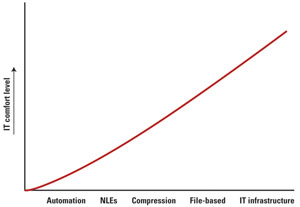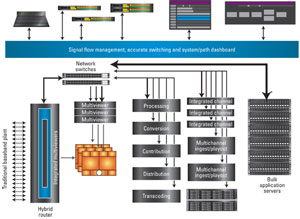Leveraging large datacenter switches
Over the next few years, we will all hear a lot about “packet-based facilities” or the “all-IP plant.” It seems like the next big thing, but really this is just the continuation of a long, steady migration that has been going on since the late 1990s.
There is no question that IT technology has slowly taken a strong foothold in broadcast plants over the past decade. Previous to this, it was considered only for financial and administrative tools — certainly not for on-air operations, much less studio and production work. Both NLEs and video servers were radical shifts for broadcasters to not only grasp, but also trust since they use IT technology. (See Figure 1.)

Figure 1. IT technology has slowly worked its way into broadcast plants over the years. As broadcasters became more comfortable with it, they have used it for more and more tasks.
At the same time, the broadcast world was wrestling with consolidating multiple functions into the baseband router that historically were performed by external equipment. Analog-to-digital audio and video conversion equipment was integrated into the core I/O of the broadcast router. Coaxial and fiber interfaces are equally available to provide for any desired connectivity. Mux/demux technology allows the creation of embedded audio infrastructures with the functionality of discrete audio plants. Integration of multiviewers into the core capability of the router functionality produced a radical shift in the design of monitor walls and how they were used.
IP delivery
Video-over-IP first began with compressed video, typically in bit rates suitable for consumer delivery of SD video signals using MPEG-2 (around 3Mb/s). At these rates, consumer television services could be offered over ADSL technology, and telecom operators in many areas began offering consumer services based on SD and MPEG-2. Supercomm in 1999 featured demonstrations of this technology from several vendors. The deployment of HDTV in the U.S. actually slowed down ADSL-based video, as ADSL technology needed to evolve enough bandwidth for HD services to homes; H.264 compression also helped to close that gap through increased coding efficiency.

Harris Broadcast’s Platinum IP3 router is designed to accept separate audio, video and data paths within the same frame.
The professional video industry's #1 source for news, trends and product and tech information. Sign up below.
The rise of digital cable TV deployments in the late 1990s provided a large digital pipe to the home. While not IP-based in the (256QAM) delivery system, the digital cable infrastructure drove a need for switching and routing of compressed video signals into every cable headend and many satellite uplink infrastructures as well. These headends began with vendor-specific bespoke interfaces but rapidly evolved to standards-based TS over IP in order to save cost and provide interoperability among vendors.
Today, most compressed video signals in headends worldwide (IPTV, digital cable, satellite and even digital terrestrial broadcasters) are switched, routed and transported using RFC2250/SMPTE 2022-formatted data over IP on Ethernet. This is now regarded as a mature stable technology with high reliability and reasonable cost structure, and coaxial DVB-ASI is relegated to special cases and test equipment.
Ethernet
Meanwhile, over the past 10 years, Ethernet interfaces and their related packet switching technologies have undergone extreme capability growth. Twelve years ago, GigE was mostly on fiber, and fairly expensive. Today, 10GigE on Cat 6A copper is widely available, and highly capable Ethernet switches with hundreds of 10GigE ports are available from multiple vendors at reasonable (for what they are) prices. Fiber-based 40Gb/s — and even 100GigE interfaces — are available in these same switches. This capability growth, and the large marketplace of high-capacity switches, is driven by the rise of large-scale datacenters and cloud/virtualization centers, a demand generator that is larger than the broadcast equipment industry and likely to continue for many years.
SDI
Inside the broadcast plant, SDI technology has also evolved, matured and improved over the same time period, with advances in re-clocking and equalization technology enabling 3Gb/s SDI signals over 390ft of coaxial cable, and 3Gb/s capability across SDI routing fabrics up to thousands of ports at ever-declining cost. Fiber interfaces for SDI have also been standardized and packaged using interchangeable SFP optics, further reducing cost and improving interoperability of SDI infrastructure. HD-SDI today is one of the most vendor-interoperable interfaces in the broadcast industry.
Routers
But an SDI router is more than just a switcher of bits; the routing control system (RCS) is the organizing fabric of the plant. The RCS gives human, operational names to the signals, groups them logically and provides a consistent operational interface to the people and automation systems. An operator needs to select the source and destination regardless of which format or transport structure the signals are currently in. This requires a control structure that takes into account conversion and intelligent tie-line management to perform the grunt work of ensuring a seamless flow of signals throughout the plant.
While the core plant may evolve with video and audio signals transitioning to being carried over IP/Ethernet technology in the future, the unifying control layer provided by the RCS is more important than ever, integrating the various IP-connected endpoints into an operational, controllable system.

Figure 2. Hybrid plants will exist, with islands of coaxial and islands of IP bridged together. The routing control system will make it act like one plant in the same way it does today with multiple routing matrices.
IP/Ethernet technology promises to revolutionize the plumbing of the plant. Instead of expensive coaxial cables carrying pixels to a central “house router,” equipment can be interconnected with simple 10GigE cables to Ethernet switches, consolidated together with 100GigE fibers. Hybrid plants will surely exist (and may be the norm) with islands of coaxial and islands of IP bridged together. (See Figure 2.) The RCS will make it act like one plant in the same way it does today with multiple routing matrices. The efficiencies come over time through reduction in the number of cables, the types of cables and the installation/maintenance effort. Over time, endpoint equipment will have native IP interfaces for video and audio, enlarging the IP infrastructure, but the RCS will still be the control layer that makes it “act like a router.”
The finished look and feel of television programming today depends on frame-accurate control of switching, graphics and playout, with careful time-alignment of signals to switch cleanly. Traditional SDI routers, SDI playout servers, SDI switchers and SDI graphics inserters provide this frame-accurate execution and clean switching today at reasonable cost and great scale. Saving money on improved plumbing will only be welcome if it also produces competent-looking output.
In the future
As an industry, we are working through the standards, practices and methods required to produce excellent television using packet-based technology. Standards for how to do all this on IP are being worked on today. While a few early adopters may deploy limited-functionality IP infrastructure in 2014, we anticipate “functional parity” of IP-based production systems with current top-of-the-line baseband systems sometime in 2016 or early 2017.
So what does this “plant of the future” look like? If the past is any indication, the plant of the future will look, at first, a lot like the plant of today. It will still produce television content by putting together segments of programming and interstitial elements including advertisements. It will still handle live news and live sports, and deliver them through many parallel delivery systems to millions of consumers. The underlying technology may change at some levels, but the core mission of the plant remains the same: to produce and deliver the content people want, at an appropriate quality level, through multiple delivery systems and to multiple devices.
—John Mailhot, Solutions Architecture, Harris Broadcast.

John Mailhot has worked in the field of digital high-definition (HD) television systems since its North American inception in 1990. He began as part of the AT&T-Zenith team, responsible for system architecture and integration of the digital spectrum compatible high-definition television (DSC-HDTV) system prototype, and then served as technical lead for the Grand Alliance encoder at Lucent Technologies. He subsequently held engineering manager and general manager roles at Lucent Digital Video, Aastra Digital Video, and the Harris Broadcast Video Networking Group. Today, John Mailhot is Senior Vice President, Product Management at Imagine Communications. He has dual bachelor’s degrees in computer science and electrical engineering from the Massachusetts Institute of Technology (MIT) and has been recognized as a SMPTE Fellow.
